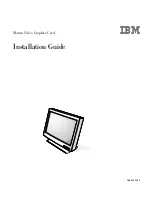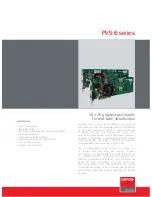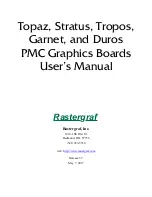
RTD Embedded Technologies, Inc.
|
www.rtd.com
15
USB25407 and USB35407 User’s Manual
5
Functional Description
Block Diagram
The Figure below shows the functional block diagram of the USB25407. The various parts of the block diagram are discussed in the following
sections.
Figure 6: USB25407 Block Diagram
Current Limited Boost Converter
The USB25407 has four over-current protected boost converters, one for each connector. These serve two functions. The first function is to
limit the current output of the port to 900mA. The second function is to ensure that the output voltage at the connector meets the USB
requirement of 5V ± 10%, regardless of the input voltage. Even when the board is at its minimum input voltage of 4.75V, the output voltage at
the USB connector will be 5V typical.
PCI Express Repopulation
The USB25407 provides a PCI Express packet switch to repopulate the lane that it uses. The uplink for the switch is attached to the host
through the PCIe/104 bus. One of the downlinks is attached to the USB 3.0 controller. The other downlink is fed back to the PCIe/104 bus,
and provides connectivity to the fourth card in the stack from the USB25407. This allows the PCIe/104 system to grow beyond the four PCIe
x1 links that can be provided by the host. If all of the peripherals in the system provide repopulation, a very large number of peripherals can be
used.
Driver Support
For Windows XP and Windows 7, the USB25407 is supported by an USB driver provided by Texas Instruments. A copy of this driver is
provided on the companion CD that is shipped with the board, and may also be downloaded from the RTD web site (
www.rtd.com
) or the TI
web site (
www.ti.com
). It is recommended that you frequently check the RTD web site for updated documentation and drivers.
Linux support is available in Kernel version 2.6.37 or later. Early Linux support for USB 3.0 has been shown to have issues with USB 3.0 Hubs,
therefore we recommend using Kernel version 3.1.0 or later.
PCIe packet
Switch
PC
Ie
Bu
s
PCIe x1
+5V
TI
TUSB7340
USB 3.0
Controller
USB 3.0
Port 0
Boost/
Current
Limit
PCIe x1
(repopulate)
USB 3.0
Port 1
Boost/
Current
Limit
USB 3.0
Port 2
Boost/
Current
Limit
USB 3.0
Port 3
Boost/
Current
Limit





































